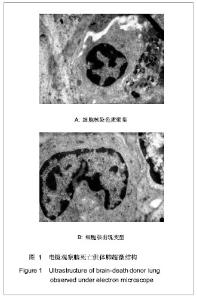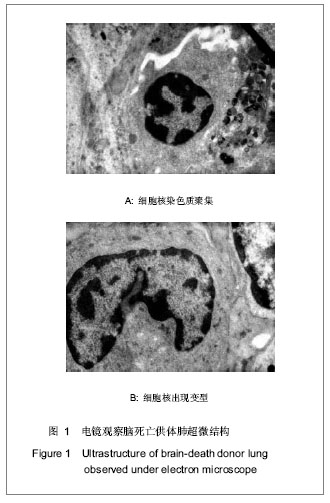| [1] |
Yang Xin, Jin Zhe, Feng Xu, Lu Bing.
The current situation of knowledge and attitudes towards organ, eye tissue, body donation of residents in Shenyang
[J]. Chinese Journal of Tissue Engineering Research, 2021, 25(5): 779-784.
|
| [2] |
Liu Luhao, Fang Jiali, Zhang Lei, Li Guanghui, Xu Lu, Lai Xingqiang, Xiong Yunyi, Chen Rongxin, Ma Junjie, Chen Zheng.
Clinical assessment criteria of donor pancreas transplants for simultaneous pancreas-kidney transplantation
[J]. Chinese Journal of Tissue Engineering Research, 2020, 24(26): 4157-4161.
|
| [3] |
Ding Yubin, Tang Yufeng, Tang Xudong.
Application and research advances in stem cell
transplantation for severe aplastic anemia
[J]. Chinese Journal of Tissue Engineering Research, 2020, 24(19): 3084-3092.
|
| [4] |
Wei Yuanfeng, Huang Dongping.
Current status of hematopoietic stem cell transplantation in
the treatment of aplastic anemia
[J]. Chinese Journal of Tissue Engineering Research, 2020, 24(19): 3093-3100.
|
| [5] |
Liu Zhiling, Gao Minghong, Chen Yingxin.
Bio-engineering cornea versus human donor cornea in the treatment of fungal corneal ulcer
[J]. Chinese Journal of Tissue Engineering Research, 2020, 24(10): 1563-1569.
|
| [6] |
Cai Qiucheng, Fan Hongkai, Xiong Rihui, Jiang Yi.
Intravenous administration of bone marrow mesenchymal stem cells protects liver function following fatty liver transplantation from donors after cardiac death
[J]. Chinese Journal of Tissue Engineering Research, 2019, 23(17): 2625-2629.
|
| [7] |
Jiang Shanshan, Wang Feng, Yu Limei.
Immunomodulatory properties of mesenchymal stem cells and their application in organ transplantation
[J]. Chinese Journal of Tissue Engineering Research, 2019, 23(1): 103-109.
|
| [8] |
Li Ling1, Xu Qian1, Wei Wan-hui1, Zhao Hui-jia1, Shi Yu-ying1, Liu Lu1, Wang Yan-feng1, Ye Qi-fa1, 2 .
Lung injury and inflammatory responses in a rabbit model of brain death
[J]. Chinese Journal of Tissue Engineering Research, 2018, 22(28): 4481-4486.
|
| [9] |
Liu Teng-fei, Zhou Jian-kang, Huang Tuan-jie, Xing Qu, Cheng Kang, Li Peng, Li Dong-peng, Yang Bo, Ma Shan-shan, Guan Fang-xia .
MG53 protein protects against multiorgan ischemia/reperfusion injury: present and future
[J]. Chinese Journal of Tissue Engineering Research, 2017, 21(20): 3248-3254.
|
| [10] |
Li Jin-feng, Sun Jia-jia, Feng Gui-wen, Shang Wen-jun, Pang Xin-lu, Liu Lei, Xie Hong-chang, Feng Yong-hua, Wang Zhi-gang.
Effect of donor and recipient gender on the recovery of renal function after donation after cardiac death renal transplantation
[J]. Chinese Journal of Tissue Engineering Research, 2017, 21(16): 2593-2599.
|
| [11] |
Li Ling, Li Ning, Ai Zi-ye, Yao Ya-jun, Wei Wan-hui, He Wei-yang, Wang Yan-feng, Ye Qi-fa.
Intra-patient variability of tacrolimus concentration in transplant recipients:
a prognostic predictor post transplantation
[J]. Chinese Journal of Tissue Engineering Research, 2016, 20(49): 7437-7422.
|
| [12] |
Lin Jing-xia, Su Fan, Luo Hong-shan.
Transfusion of blood components in liver transplantation and abdominal multiple organ transplantation
[J]. Chinese Journal of Tissue Engineering Research, 2016, 20(33): 4957-4962.
|
| [13] |
Dong Jian-hui, Li Hai-bin, Sun Xu-yong, Qin Ke, Liao Ji-xiang, Li Mei-si, Huang Xiao-dan, Huang Chen, Huang Ying, Cao Song, Gao Zhao, Li Zhuang-jiang, Nie Feng, Yang Jian-jun.
Clinical effects of renal transplantation with kidneys from donors dying of organophosphate poisoning
[J]. Chinese Journal of Tissue Engineering Research, 2016, 20(29): 4311-4318.
|
| [14] |
Zhang Wen-xin, Teng Sha, Peng Xiao, Lin Xiao-hong, Liu Hong-xia.
Systematic review of the effects of education on medical students’ knowledge and attitudes toward organ donation and transplantation
[J]. Chinese Journal of Tissue Engineering Research, 2015, 19(5): 810-814.
|
| [15] |
Hu Xiao-yan, Wang Yan-feng, Ye Qi-fa, Chen Zhi-quan, Fan Xiao-li, Guo Yi, Li Ning.
Effects of hypothermic machine perfusion versus static cold storage of kidney allografts on transplant outcomes: a Meta-analysis
[J]. Chinese Journal of Tissue Engineering Research, 2015, 19(42): 6882-6888.
|

